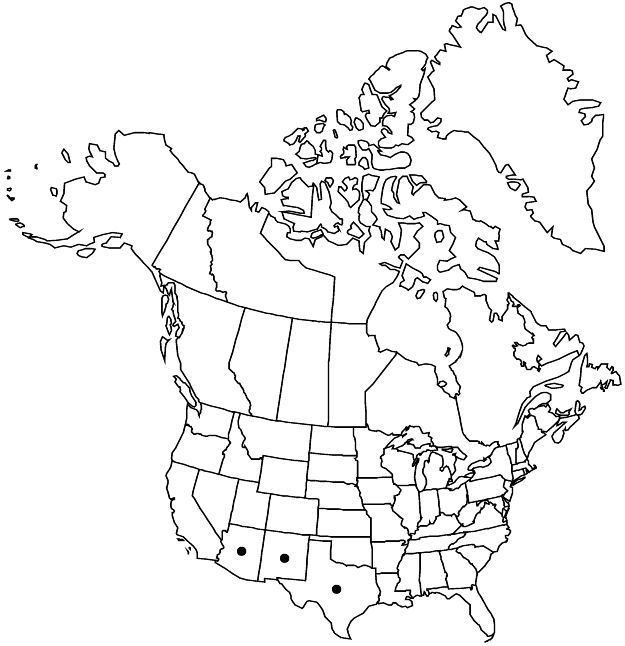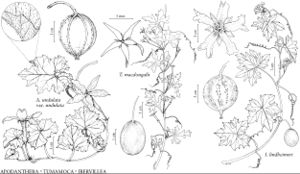Apodanthera undulata var. undulata
Vines fetid; branches to 3 m, harshly strigose; tendrils usually branched from 1–5 cm beyond base. Leaves: petiole 3–7 cm; blade 8–15 cm wide, surfaces moderately to densely white-sericeous abaxially, glabrous adaxially. Inflorescences: staminate flowers in long-pedunculate racemes; pistillate flowers in loose fascicles; peduncle erect, 1–2 cm in flower, 6–9 cm in fruit. Flowers: hypanthium 10–18 mm; sepals erect, not recurving. Pepos 6–10 cm. Seeds light brown, 9–12 mm. 2n = 28.
Phenology: Flowering May–Sep.
Habitat: Roadsides, gravelly stream terraces, interfan alluvium, dunes, flats, rocky slopes, lava beds, grasslands, creosote scrub, Chihuahuan desert scrub of Flourensia-Larrea, mesquite, oak chaparral, oak-juniper woodlands
Elevation: 800–1700 m
Distribution

Ariz., N.Mex., Tex., Mexico (Chihuahua, Coahuila, Durango, Sonora).
Discussion
Plants perennial, monoecious and dioecious (developmentally, seasonally), trailing or climbing; stems perennial proximally, annual distally, woody, glabrous [hispid-hirsute or hispidulous]; roots tuberous; tendrils unbranched. Leaves: petiolar region an extension of blade midportion; blade ovate to orbiculate, deeply 3-lobed, lobes 1–2-lobed, ultimate segments narrow, margins entire, surfaces eglandular at base. Inflorescences: staminate flowers 2–19 in axillary, subsessile racemes; pistillate flowers solitary, from same axils as staminate; bracts absent. Flowers: hypanthium narrowly tubular-funnelform; sepals 5, deltate to triangular; petals 5, distinct, pale yellow to greenish yellow, narrowly triangular to linear-lanceolate, valvate in bud, 4–6 mm, apex entire, glabrous, corolla salverform. Staminate flowers: stamens 3; filaments inserted at hypanthium rim, distinct, nearly vestigial; thecae distinct, oblong, connective narrow, each with glabrous, narrow, exserted, terminal appendage nearly as long as corolla; pistillodes absent. Pistillate flowers: ovary 3-locular, ellipsoid; ovules ca. 2–6 per locule; style 1, narrowly columnar; stigmas 3, coiled; staminodes 3. Fruits berrylike, red or yellow, globose, 0.8–1 cm, smooth, glabrous, irregularly dehiscent. Seeds 8–20, obovoid to ovoid, compressed, arillate, margins obscure, surface tuberculate-rugose.
Species 2 (1 in the flora): Arizona, n Mexico.
Tumamoca is closely related to Ibervillea. Plants of both genera produce orange to red fruits with prominently margined, red-arillate seeds. Tumamoca is distinct in its narrowly funnelform hypanthium (versus narrowly campanulate to cylindric in Ibervillea), three staminodes (versus five), entire petals (versus apices bifid), interior corolla surfaces glabrous (versus densely pubescent), valvate buds (versus buds with infolded apices), and seeds with roughened surfaces and obscure margins (versus corky-pleated surfaces and raised margins).
Tumamoca mucronata Kearns apparently is known only from the type locality in northwestern Zacatecas, Mexico.
